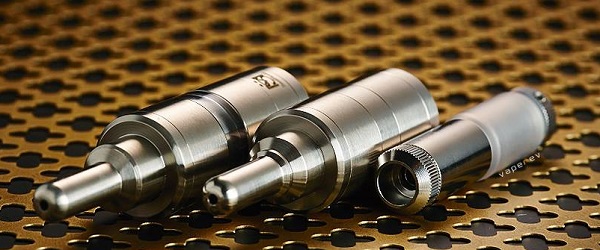
Rebuildable atomizers offer you an unprecedented level of customization over your vaping experience, as well as being a way to make vaping even more affordable in the long-term. In the simplest terms, you build your own coil and wick; they’re effectively DIY atomizers which you can adjust to your personal preferences.
There are some unique safety concerns when it comes to rebuilding atomizers, or more specifically, due to what could happen if you hit fire with a high voltage on a shorted atomizer, so it’s worth reading through a quick primer on safety before you starting coiling your kanthal.
Key Points
- Use common sense when it comes to rebuilding your atomizer: ensure the base isn’t connected to your mod while you’re building, be careful of sharp ends with resistance wire, and as always, avoid any situation in which you’ll come into direct contact with e-liquid.
- Get a multimeter, especially if you’re interested in (or have) mechanical e-cig mods. Features exist on VV/VW mods, but they’re inexpensive and a useful addition to any rebuilders’ set of tools.
- Checking your coil’s resistance regularly is crucial – a shorted atomizer could lead to an increase in current, which could push your battery past its limit and lead to a very bad situation.
- If you’re checking resistance on a VV/VW mod, remember to lower the voltage before testing, and never dry-fire cotton or (aside from in very short bursts) silica.
- If you’re using a multimeter for low resistance builds, remember that the multimeter itself has resistance. Touch the probe tips to get a reading of the lead resistance, and subtract that number from your final reading.
- If you’re doing a multi-coil build, keep your resistances equal and remember that when you wire in parallel, the total resistance of the build is the resistance of any one of the coils divided by the number of coils. Multi-coils draw more amps from your battery, so do the math!

OHMS jumping around is the sure sign of a short. Wires should not be touching each other, or the posts, or the deck. Practice practice practice. My first coils vaped and looked awful. After a while you WILL get the hang of it. It just takes practice. If juice is applied to your wick and coils, you should never see anything glowing red. – Nick “GrimmGreen” Green (GrimmGreen.com)

I'm terrible with rebuilding, but… never put a rebuildable directly on a mechanical mod to test it. Use either a multimeter or an electronic APV with resistance checking to verify the circuit is complete and the resistance is within the desired range before trying to use the device. – Steve K (Steve K’s Vaping World)

Don't cross your wires? 🙂 BUY A MULTIMETER! There are also many resistance checkers with built in 510 connections out there now. You should know what your resistance is, and whether or not you have a short, before firing your freshly made coil. – Phil Busardo (TasteYourJuice.com)
Atomizer Building Safety
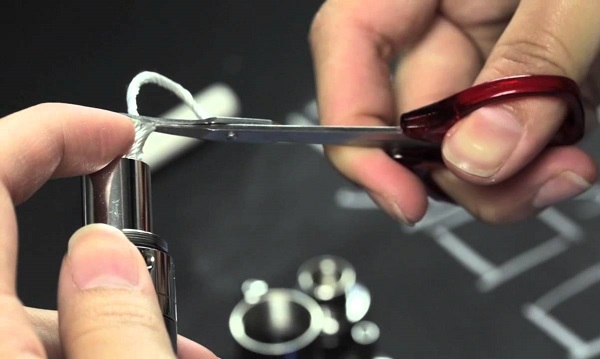
Accomplishing the building part of the process safely is pretty easy. The first thing is that you don’t want to be messing around with conductive wire and power-supplying posts while the atomizer base is connected to anything. A working coil is like an exposed electrical wire, but one that’s designed to get pretty freaking hot. So if you’re touching it, you want to make sure it couldn’t even accidently have current pumped through it.
Although we’ll come to testing your build later, it’s a good idea to find out about the resistance of the wire you’re using so you can estimate how much of it you’ll need to use to achieve a given resistance. There’s a useful guide to rebuilding your atomizer with information about the resistance of various wire gauges from Spinfuel, but if you’re just getting started and are concerned about safety, add a bit of length (an extra wrap or a slightly wider diameter) at first and try to get the resistance down when you’re used to the process.
Other than that, atomizer rebuilding safety is very much common sense. You’re snipping metallic wire, so you want to be careful to avoid pricking your fingertips with the sharpened tip (which hurts way too much for such a tiny, borderline-invisible puncture).
Additionally, you don’t want to wrap a coil around a juice-soaked wick, because you will absorb significant quantities of nicotine through your skin.
Checking Your Coil Resistance Safely
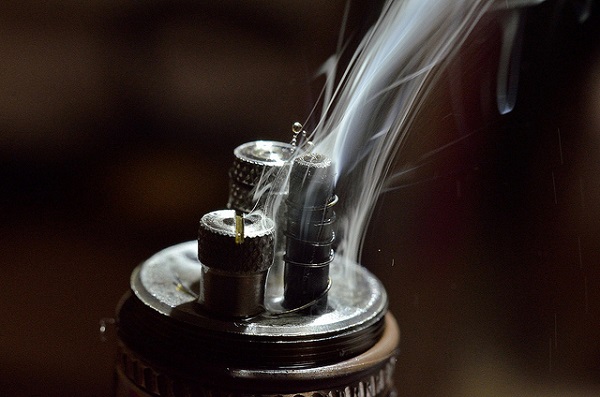
So you’ve built a coil, are feeling proud of yourself and wanting to vape it to enjoy your work. Unfortunately, doing that without checking your resistance is running the risk of overloading your battery due to a short.
If you’re getting into rebuildables, and particularly if you’re using a mechanical mod, you should get yourself a multimeter. They’re pretty cheap and you can use them to keep an eye on your battery’s voltage as well as the resistance of any coils you build. Electronically-controlled VV/VW devices like the ProVari often have these functions built in, so it isn’t, strictly-speaking necessary if that’s all you’ll be using, but multimeters aren’t expensive and cover you for if you use a mech mod in future.
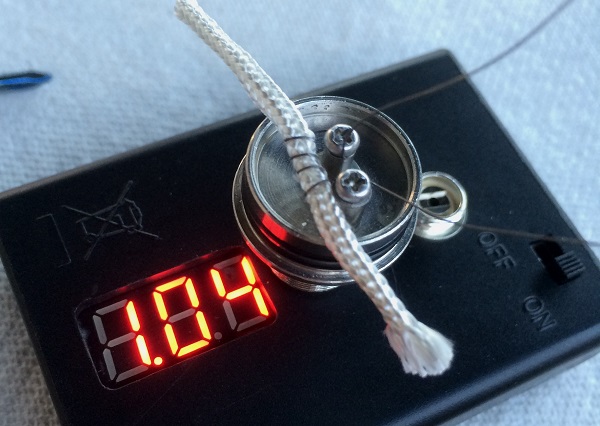
If you’re using a multimeter, you need to touch the two probes to the wire at either side of the coil to determine the resistance, and you should ensure that no power goes through the coil when you test it, because this can affect the reading. Although this is only likely to create a wildly misleading result when you get down to low resistance coils, the meter itself also has lead resistance, which you can test by touching the probes together and reading the resistance. If you’re in low-ohm territory, it’s worth subtracting this reading from the one obtained for your coil to get an accurate result. If the resistance of your coil is fairly high, just bear in mind that it’s actually a little less than the reading you’re given.
If you’re using a VV/VW mod to check the resistance, the key piece of advice is to set it to the lowest possible voltage before you connect the atomizer. When you test it (a few times, to ensure your reading is stable and guard against shorts), you’re running current through it, which could impact your battery if the resistance is too low and the voltage too high.

Additionally, it’s better to test resistance without wicking material inserted, or using SS mesh (which can be dry-burned), so you don’t have to make any adjustments after anything has been soaked in juice. Silica and cotton can’t be dry-fired, though, so if you already have the wick added (and it can’t be removed and replaced easily), drip some juice onto it to protect it during your testing. This isn’t advised, however, because with juice present the coil shouldn’t glow and you may miss a hot spot as a result.
If the reading is close enough to your intended resistance and stays stable (a drop in resistance is a warning sign for a shorted atomizer), then you can test-fire the coil using the button and check for an even glow. At this point – keeping Ohm’s law in mind – you can raise the voltage a little to get a better look at things. Any adjustments to the coil spacing (to remedy hotspots or potential shorts) should be made with a suitable thin tool, not your fingers! If everything checks out, you’re ready to add juice and give it a vape!
Multi-Coil Atomizer Building Safety
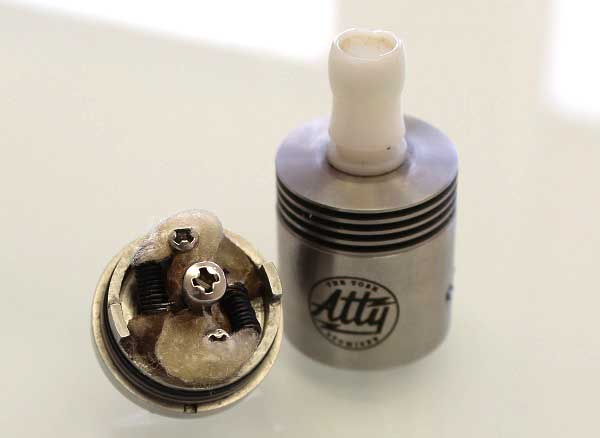
Many vapers opt to build dual, triple or even quad coil atomizers, effectively as a method of improving vapor production by reducing the overall resistance and increasing the surface area which vaporizes liquid. This is great for “cloud-chasers,” but as with most elements of the hobby there is some safety advice to take into account before you start to build your multi-coil atomizer.
As we covered in the last article, one of the main concerns when you’re building anything with low resistance is the number of amps drawn from your battery, in accordance with Ohm’s law. When you build dual, triple or quad coil atomizers the resistance is slashed, so you need to take this into account. Again, this is primarily a concern for mechanical mod users, as electronic VV/VW devices would throw up an error if you tried to fire anything with too low a resistance, but it’s still useful knowledge for anybody getting involved with multi-coil atomizer builds.
The basic advice is to make coils with equal resistances (aim for identical) and the math is very simple. Dual coils are wired in parallel, which means that the overall resistance is reduced rather than increased. If you have identical coils (checking resistance individually to confirm is always a good idea), then you simply take the resistance of any one of them and divide it by the number of coils. So, for two 1.8 Ω coils wired in parallel, you have 1.8/2 = 0.9 Ω total resistance. Running 3.6 V through this would result in a current of 4 A, whereas if you were only using one it would just be 2 A; illustrating the potential issues with maximum continuous discharge limits for batteries.
This also means that triple and quad coils become even more of an issue. If you used four 1.8 Ω coils in parallel the total resistance would be 1.8/4 = 0.45 Ω and with the same voltage applied would draw 8 A of current – more than enough to fry an 18350 battery. Larger batteries are essential for multi-coil builds for this reason, and it’s always important to make sure you’ve done the math right. This is another reason identical coils are preferred. If for whatever reason you do need to calculate for unequal coils, the formula is:
1/R = 1/R(1) + 1/R(2) + 1/R(3)+ …
Where R(1), R(2) and R(3) are the resistances of the three coils. If you don’t like the look of calculating this: keep your coils even. If you have to: here’s a quick example. With two coils of 1.5 Ω and 2 Ω, the reciprocal of the total resistance (one divided by the total resistance) is given by:
1/R = 1/1.5 Ω + 1/2 Ω = 0.6666… + 0.5 = 1.1666…
So the resistance is 1/1.1666… ≈ 0.86 Ω. Always remember this final step, because it could make all the difference for you battery. If you can turn the resistances into fractions it’s easier to calculate in your head, because a reciprocal of a fraction is just the same fraction turned upside down. For example, a 1.6 Ω coil is 8/5 Ω, so it’s reciprocal is 5/8.
Short Circuits and Batteries
A short circuit is a low-resistance path that may draw way too much current from your battery. This is why it’s essential to check your resistance regularly when you’re rebuilding atomizers.
Additionally, this is why it’s essential to heed the information regarding battery safety when you’re building low-resistance (especially sub-ohm) coils. In any coil, a short circuit is a problem that should be addressed immediately, but on a coil that is already low in resistance it could lead to a catastrophic meltdown or thermal runaway.
Follow the advice from the previous post and always err on the side of caution.
Conclusion
Rebuilding atomizers isn’t dangerous, but it can be if you make a serious mistake on a device which doesn’t afford additional protection. In any case, looking out for shorts – and being aware that dealing with conductive coils, wicks and electrical posts inherently requires some caution – will ensure that you can enjoy your customized vaping experience safely.
The Complete Guide to E-Cig Safety
Part One: Beginner E-Cigs Safety
1. Safe Use of Beginner E-Cigs
2. A Guide to Safe Charging
3. Carrying Your E-Cig Safely
4. Cartomizer Safety
5. Vaping and Driving
Part Two: E-Liquid Safety
6. Basic E-Liquid Safety
7. Allergies, Conditions and E-Liquid
8. Safe Nicotine Consumption for Vapers
9. Steeping E-Liquids Safely
10. Do E-Liquids Expire?
11. E-Liquid and Tank Safety
12. DIY E-Liquid Safety
Part Three: E-Cig Mod Safety
13. Minimizing the Risk of E-Cig Mod Explosions
14. E-Cig Mod Battery Safety and Ohm’s Law
15. Rebuildable Atomizer Safety
16. Mechanical Mod Safety
17. Wick Safety
18. Drip Tip Safety

